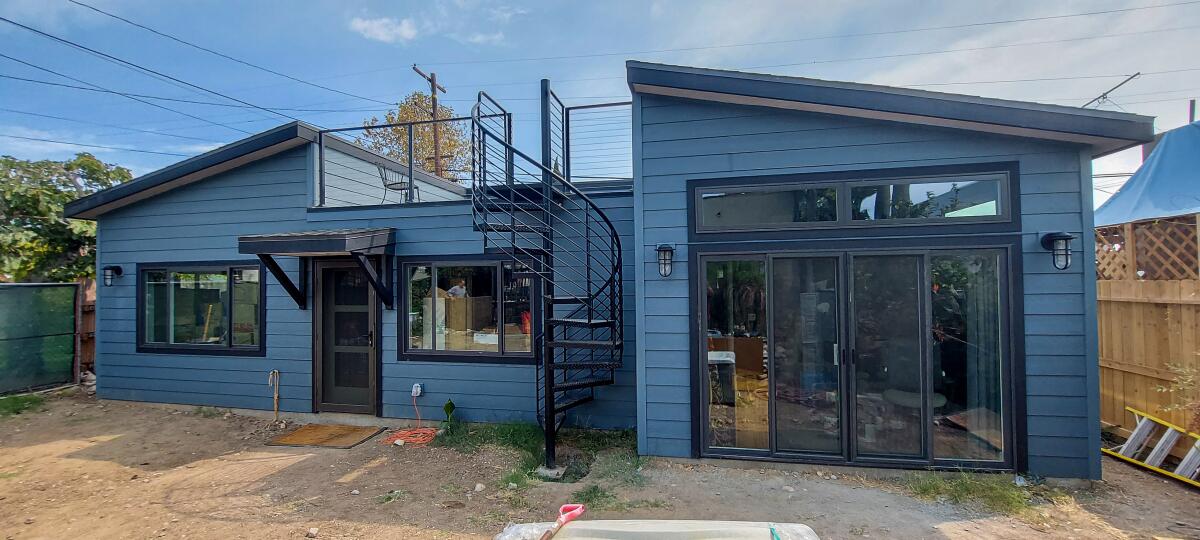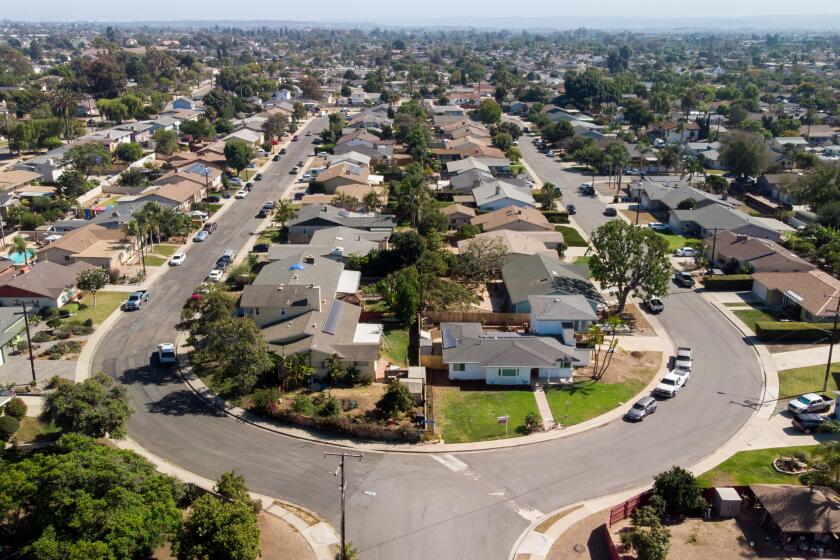Outcry over granny flat construction in San Diego prompts rule change proposals

- Share via
SAN DIEGO — Growing outcry over granny flat construction in some San Diego neighborhoods has prompted officials to propose rolling back some recent policy changes that have made the city’s rules among the least restrictive in California.
Critics who say the city’s granny flat rules are too lenient call the recently proposed rollback from Councilman Sean Elo-Rivera a good start. But they say it won’t prevent some property owners from destroying neighborhood character by building multiple granny flats in one backyard.
Proponents say granny flats — which city officials call accessory dwelling units, or ADUs — are the cheapest and fastest way to solve San Diego’s housing crisis. They say Elo-Rivera’s proposal is an overreaction to a problem that isn’t widespread and probably never will be.
People on both sides of the issue agree that how the city balances its incentives to build granny flats with its restrictions on them will probably affect the look and feel of many San Diego neighborhoods for decades to come.
Elo-Rivera is proposing a series of complex adjustments to the rules that aim to increase the added units’ availability to low-income tenants and to prevent corporate investors from turning granny flats into a lucrative business.
Elo-Rivera’s district includes Kensington and some other areas that have loudly opposed loosening granny flat rules.
He wants new parking restrictions and a requirement to replace any trees removed to make way for a granny flat.
He also proposes charging the owners of large granny flats ongoing maintenance fees, to help pay for new infrastructure needed to accommodate the additional residents living in a neighborhood’s granny flats.
His six-page multi-pronged proposal comes after the first backlash against the city’s looser granny flat rules emerged last spring in Kensington, Talmadge, Rolando and other nearby neighborhoods.
Mid-city residents say new policy allowing bonus units could destroy single-family neighborhoods
Opposition has since spread to the College Area and other communities, and the opponents have formed a well-organized lobbying organization called Neighbors for a Better San Diego.
Though the group is praising Elo-Rivera for addressing the issue and applauding some of his ideas, they stress that his proposal would not eliminate one issue that has prompted the most opposition: a granny flat density bonus.
That policy, adopted last fall by the City Council, goes beyond state law by allowing property owners to construct extra granny flats on their property if they agree to rent restrictions on at least one of them.
While state law does not include bonus units, San Diego allows any property owner willing to build a rent-restricted granny flat to build one bonus flat that can be rented at market rate.
And if the property is within a half-mile of an existing or planned transit line, the property owner can build multiple bonus granny flats if they also build an equal number of rent-restricted flats.
The residents say that “density bonus” will destroy neighborhood character, making residential zoning mostly meaningless. They said it also will exacerbate parking scarcity in many neighborhoods and lengthen the time it takes to get to freeways in others.
“The density bonus has made the [granny flats] program more impactful than it has to be,” said Geoff Heuter, one of the group’s leaders. “We like some of Elo-Rivera’s proposals, but there’s a gap between what he is proposing and what needs to be done.”
Elo-Rivera wants to strengthen the affordability component of the density bonus by requiring that tenants in rent-restricted granny flats earn less than 80% of the area’s median income, down from the 120% now allowed.
Elo-Rivera said eliminating the density bonus altogether would sharply limit the potential of granny flats to help solve San Diego’s affordable housing crisis.
“Solving our housing crisis requires density,” said Elo-Rivera, adding that concerns about climate change prevent cities from building more housing in outlying areas.
He said granny flats are ideal because of their relatively low cost and their location.
“Housing must be created and it must be close to jobs and shopping, so ADUs need to be part of our policy,” he said.
Senate Bill 9, signed by Gov. Newsom, allows a lot with one single-family lot to be turned into up to four units.
To prevent real estate speculation by corporate investors, Elo-Rivera is proposing a significant change to a city policy that waives developer impact fees for granny flats. Such fees usually help pay for libraries, fire stations and other amenities.
Under his proposal, the fees would continue to be waived for granny flats on owner-occupied properties, so property owners wouldn’t be charged. But the fees would be restored if the property is not owner-occupied or is owned by an investor, corporation or real estate trust.
Elo-Rivera said the only people with any reason to oppose that change are developers planning to take advantage of the city’s looser granny flat rules to build many flats and make them rental properties.
“They are probably not going to be thrilled with this,” he said.
Gregg Cantor, chief executive of Murray Lampert Design, Build, Remodel, said city policies should favor granny flats built by families living on-site so they can provide housing for a relative or a tenant.
He said developers are buying up properties so they can build granny flats and make them rentals.
“Granny flats are a big part of our business, but we are focused on the family side of it,” he said. “I would like to see something in place because there is so much anger, particularly about parking.”
Proponents of granny flats say Elo-Rivera’s proposal and policy changes requested by Neighbors for a Better San Diego would be an overreaction. They say only a sliver of properties would be eligible for the granny flat density bonus.
Elo-Rivera strongly disagreed, contending that many of the community complaints are valid and need to be addressed.
“I reject the premise that it’s an overreaction,” he said.
Elo-Rivera said he and his staff met with Neighbors for a Better San Diego at length so he could absorb and thoroughly understand their concerns.
Many of their concerns are valid, and they are addressed in his proposal, Elo-Rivera said. But some others seemed to be motivated by wanting to keep out certain kinds of residents, he said.
“Some of their concerns are honest and legitimate, but some seem like a pretext for not wanting new neighbors and certain types of neighbors,” he said.
Part of the disconnect might be perspective, he said.
“Some folks are focused mostly on the buildings that will be coming, but for me it’s about who will live in those buildings,” said Elo-Rivera, calling granny flats a way to make middle-class areas affordable to many San Diegans for the first time.
Neighbors for a Better San Diego says its concerns are focused entirely on keeping San Diego’s neighborhoods livable for residents. They say neighborhoods with large lots featuring relatively small houses on them are ripe for explosions in granny flats.
Geoffrey Hueter of Neighbors for a Better San Diego said his group also is disappointed Elo-Rivera’s proposal doesn’t change a city rule allowing granny flats to directly abut property lines, a policy allowing them to be 30 feet tall.
San Diego’s rules are much less restrictive than the state’s on many of these issues.
The state requires 4-foot buffers to property lines and a 16-foot height limit, and it doesn’t allow people to build bonus granny flats if a flat is rent-restricted, as the city does.
Loose granny flat rules in San Diego have helped spur a sharp increase in construction.
Granny flat construction in the city climbed from nine units in 2016 to 386 units in 2020. The increase has been steady: 13 in 2017, 61 in 2018 and 202 in 2019.
Approval of new granny flats has followed a similar trend. The 14 units approved in 2016 climbed to 19 in 2017, 237 in 2018, 501 in 2019 and 541 in 2020.
Another factor in the debate is Senate Bill 9, a new state law that requires cities to allow up to four dwellings on many single-family lots.
Neighbors for a Better San Diego says city officials should immediately stipulate that any property owner taking advantage of SB 9 is prohibited from also building granny flats on his property.
Elo-Rivera said he’s open to listening to their proposal.
Mayor Todd Gloria has left leadership of the possible rollback of the city’s granny flat rules to Elo-Rivera.
“Whether you call them accessory dwelling units, granny flats, second units or casitas, they are a critical component of our city’s efforts to increase the supply of homes that San Diegans can afford,” Gloria said.
More to Read
Sign up for Essential California
The most important California stories and recommendations in your inbox every morning.
You may occasionally receive promotional content from the Los Angeles Times.















